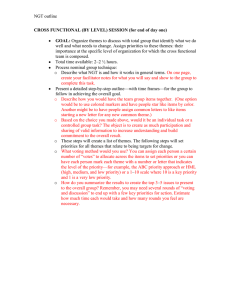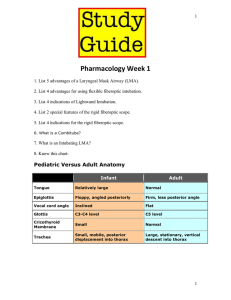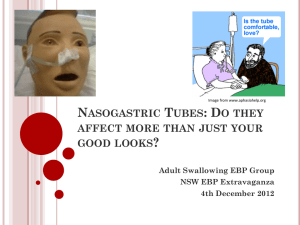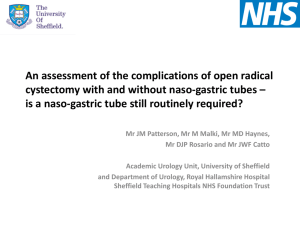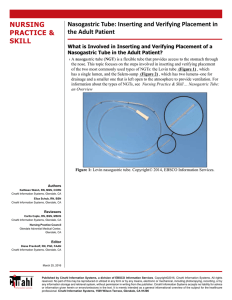Nasogastric Tube Syndrome
advertisement
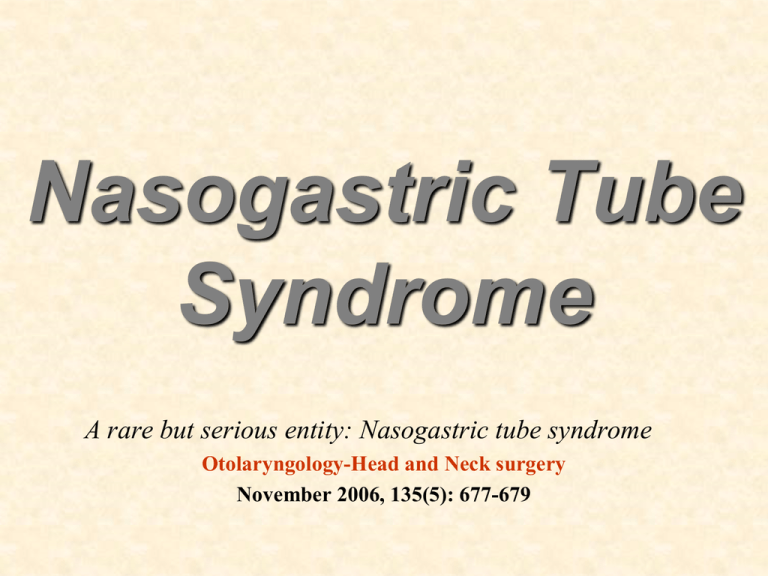
Nasogastric Tube Syndrome A rare but serious entity: Nasogastric tube syndrome Otolaryngology-Head and Neck surgery November 2006, 135(5): 677-679 History • 1790 : First description of NGT & its use [Hunter] • 1939 : Earliest report of laryngeal injury following NGT [Wangensteen] • 1990 : Description of the triad of NGTS [Sofferman]: Nasogastric intubation Throat pain Vocal cord paralysis (usually bilateral ) Complications of NG intubation • Nasal alar necrosis • Synechiae • Epistaxis • Nasopharyngitis • Eustachitis • Arytenoid edema • Nasogastric tube syndrome Pathophysiology • Possible mechanisms : Mobile laryngeal structures rub against the fixed NGT While supine, the cricoid compressed the NGT against the spine Tonic contraction of the cricopharyngeus muscle pulls the NGT against the delicate and thin posterior cricoid mucosa • Position of NGT Lateral or Midline ? This is a problem • Moderate to marked inflammation of postcricoid in midline position • Only 6% of NGTs are placed in midline Clinical Manifestations • Presenting symptoms : Pain (62%) Dyspnea (14%) Stridor (43%) Otalgia (5%) Dysphagia (29%) Fever (5%) Hoarseness (24%) • Findings on nasolaryngoscopy : Vocal cord paralysis (100%) Cricoid abscess (6%) Cricoid ulceration (41%) Midline cleft (6%) Cricoid granulation (12%) Diagnosis • Problems for diagnosis : Lack of specific warning signs Lack of temporal relationship with intubation symptoms appear between 12h after INTUBATION to 2w after EXTUBATION • Diagnosis relies heavily on : Clinical suspicion Development of complications Pain is an important early symptom and should not be ignored and should prompt a through clinical assessment Use the smallest-bore tubes as much as possible Assessment • Full head & neck examination ( R/O other causes ) • Nasolaryngoscopy ( evaluate TVC function & ulceration ) • Possible esophagoscopy ( evaluate postcricoid area ) • Sonography or CT of Neck ( R/O compressive causes ) • Tracheoesophageal cleft should be considered • Bx & culture in overt ulceration • AP neck X- ray ( position of NGT ) Treatment • No consensus with respect to treatment Parenteral steroids Epinephrine Antibiotic ( prevent abscess formation ) Tracheotomy ( set should be kept at the bedside in cmpromised airway ) 50% require tracheotomy Nutritional support ( because of delay in return to function ) • Full recovery time is variable but 100% Return to normal TVC function : 1 day to 2 months (mean : 2 weeks ) Longer time to recovery in diabetic patients Impaired immunity may increases the risk of inflammation & ulceration With best wishes S. Dabiri
